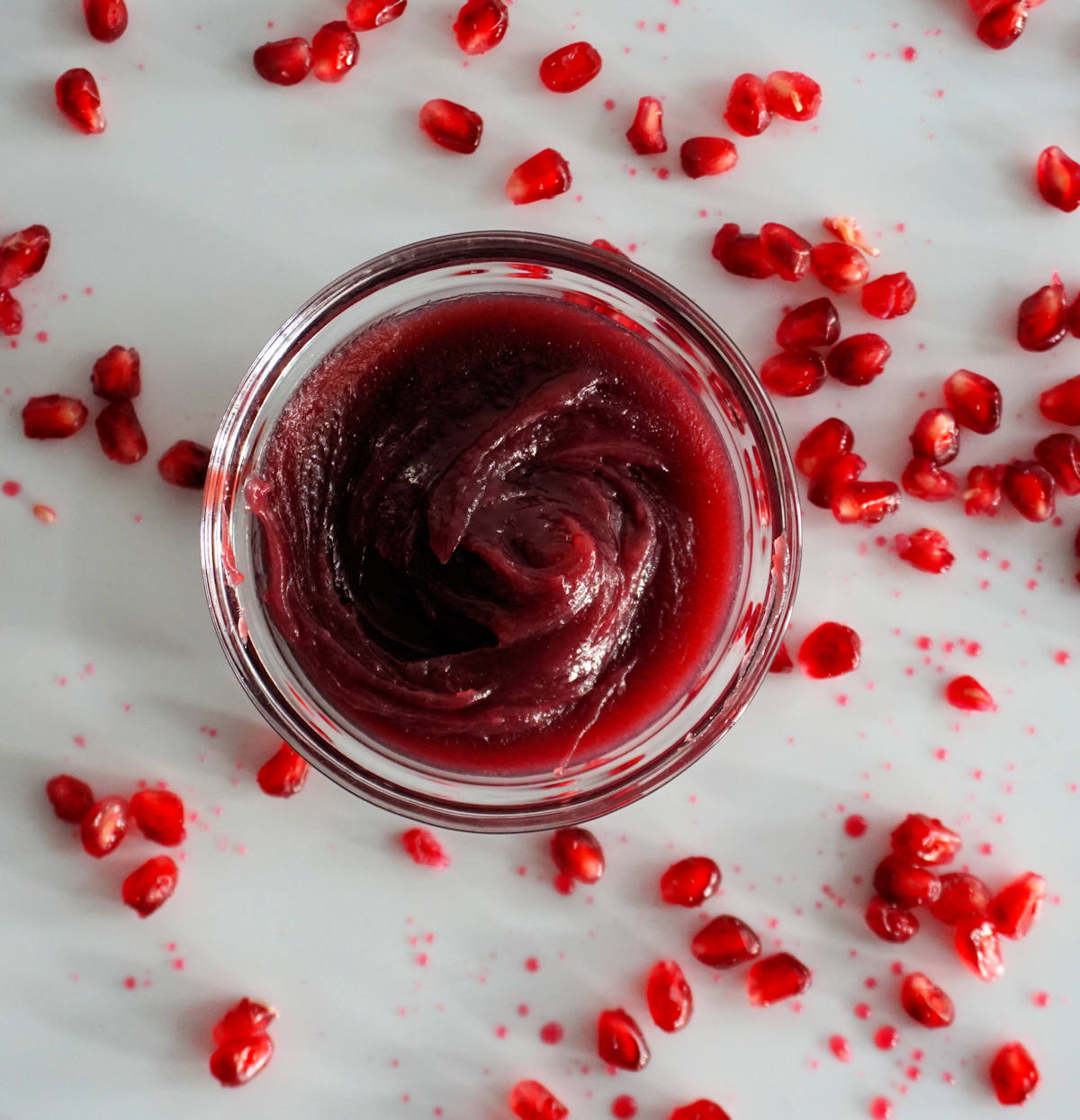Pomegranate curd is a velvety, dusky pink sweetness that can be folded into yoghurt, layered in a cake, spooned onto pancakes – or eaten with a spoon from the jar.

What is curd?
It does not sound appealing, does it? ‘Curd’ is something that appears in milk when it’s gone off – curdled, in other words.
And it is precisely that: the meaning of ‘curd’ is coagulated milk, very crude cheese, clumped milk proteins separated from whey when attacked with an acidic substance like lemon juice, or rennet in cheesemaking.
So there is curd-cheese, but there is also fruit curd also sometimes, funnily enough, called fruit cheese. It is the loveliest, sweet spread used in cakes, desserts and pastries.
What’s in fruit curd?
The ingredients are simple: fruit juice or puree, sugar, eggs or egg yolks and butter.
There are curds made without butter but I don’t respect those: it is butter that makes fruit curd so wonderfully velvety and smooth.
I’d sooner skip the eggs though that is not an option: eggs are responsible for emulsifying the mixture.
How to make fruit curd?
Simple but a little finicky: eggs need to be tempered but not scrambled, and butter must be added very gradually lest it splits.
It’s quite like making custard: you have to know what you’re doing and take your time doing it.
But the microwave method, although not particularly speedy, makes it much easier.
Pomegranate juicing
When pomegranates are at their very best, peak season, there’s no chance of me making curd: I just eat them by a bagful. It’s when they are rather tart but awfully juicy, at the start of their season, that this recipe comes into daylight.
Poms are a little tricky to juice but – as long as you’re not afraid of a bit of a mess in your kitchen – you can halve them and use a citrus juicer.
Another method is banging them into obedience, almost literally. You can whack the kernels (they are called arils) out of the skin by banging halves with a wooden spoon, holding them over a large (mess! splatter!) bowl. There are plenty of demos out there anyway.
I like the latter method because that means a/ I can sneak a few arils at a time and b/I pass them through my food mill which extracts the very last drop of juice from the little beasties.
Once you have a full cup of juice, it’s time to turn the microwave on.
Microwaved curd
The key tool is a large bowl: the mix is going to bubble and fizz, foam and sputter like crazy so make sure there is space for it to expand at least three times of the initial volume. Plus, if the bowl is not large enough, the microwave is going to be covered in splatter.
Egg and yolks need only a little whisking together to combine, followed by pomegranate juice. When you add blobs of softened butter, it looks like an ice cream mix gone horribly wrong.
And now it’s all about nuking and whisking, nuking and whisking at 30 second intervals, while the curd is curdling.
It gets hotter, then it gets darker, then finally, after eight minutes or so, it gets thicker.
If you get very impatient and the mix is safe from boiling over, you might extend the microwave bursts to one minute by the end of the process. A thermal probe or an infrared thermometer will be handy, showing at least 86C which indicates the curd is ready.
It will still be runny at this stage but thickens nicely and quickly when it chills.
Pour it into a clean jar or container and store in the fridge.
How to use pomegranate curd?
What a silly question. You just eat it from the jar with a spoon.
Joking aside, just as you would a commercially produced curd: as a filling for a pie or a sponge cake, spread on scones or buns, a topping for pavlova, folded into whipped cream for a quick dessert, dolloped onto your breakfast porridge, spooned over pancakes or folded into Greek yoghurt for breakfast.
Other fruit curd flavours
I should really call this ‘a universal curd recipe’ rather than just ‘pomegranate’.
It will work beautifully with oranges and lemons simply replacing one fruit juice with another, leaving the rest of the recipe intact.
Grapefruit and lime will need a little less juice as they are very tart and sour, while things like passion fruit or mango, whilst they make wonderful curd, are difficult to juice.
Raspberries and cranberries, blackberries and other berries including redcurrants (which are also berries) all make good curd too.
More pomegranate recipes
Pomegranate jelly is extremely flavoursome, great with panna cotta or with Greek yoghurt. My personal favourite: pomegranate jelly and cream cheese on a rice cake.
It isn’t at all difficult to make pomegranate molasses at home and it has many uses: as a glaze on chicken or pork, mixed in dressings and drinks and many more.
Twice cooked beetroots baked with figs, pomegranate and soft goats cheese. The recipe for an ultimate red food dish.